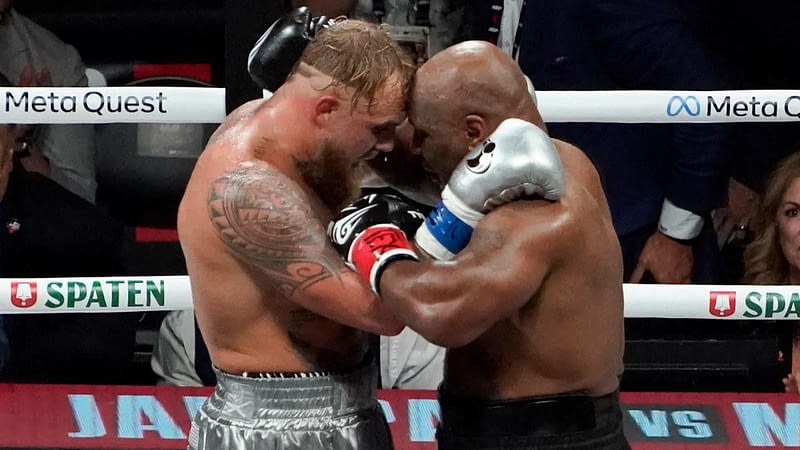The Showdown: Mike Tyson vs. Jake Paul
In a world where surreal headlines have become increasingly common, one story stood out recently: legendary boxer Mike Tyson stepping into the ring with YouTuber-turned-boxer Jake Paul. Among fans and pundits alike, this was more than just a fight. It was an event, blending the flairs of entertainment, nostalgia, and the unpredictability of modern-day celebrity match-ups. But alongside all the drama and attention surrounding it, the big question many are asking is: how much did Tyson and Paul really make from this highly publicized bout?
As with many giant combat sports events, the money involved in these fights often generates as much excitement as the actual punches thrown in the ring. Not to mention, curated marketing, massive viewership, and attention to social media all play a big role in determining fighter payouts. Let’s take a deep dive into the dollars and cents behind this iconic clash.
Breaking Down the Big Bucks
It should come as no surprise that Mike Tyson and Jake Paul both secured massive paydays for their efforts. Here’s a closer look at how much each fighter walked away with:
- Mike Tyson: Tyson, a name synonymous with boxing greatness, is no stranger to earning significant sums in the ring. For this exhibition, the former heavyweight champion reportedly secured a whopping $10 million payout. This covers base pay, incentives, and a share of the pay-per-view (PPV) sales. It’s a far cry from his financial troubles of the past, proving that Tyson’s star power remains unshaken even years after retirement.
- Jake Paul: The YouTuber has made waves in the boxing world ever since he transitioned to professional fighting. While he isn’t on Tyson’s level yet in terms of legacy or skills, Paul’s ability to draw a younger crowd, especially from the social media world, makes him an invaluable player in today’s boxing scene. He reportedly earned around $5 million for the fight, including PPV earnings. Not bad for someone whose boxing journey began just a few years ago!
The fight saw massive attention on PPV platforms, giving both fighters a healthy chunk of earnings from the viewership numbers. These earnings are crucial in determining the final figures earned by any fighter in large-scale events like this one.
What Drives These Huge Earnings?
Let’s zoom out for a moment. In fights like these—part boxing, part entertainment—there’s more going on than just what happens in the ring. Tyson and Paul’s earnings are not just based on their physical performances. Here’s what truly drives these money-making juggernauts:
- Pay-Per-View Sales: One of the biggest portions of earnings comes from PPV sales. With both fighters boasting enormous fan followings, the Tyson-Paul fight reportedly sold hundreds of thousands of PPV buys. For VIPs like Tyson and Paul, PPV points (a percentage that they earn from each sale) can often lead to multimillion-dollar earnings after the dust settles.
- Sponsorship Deals: The moment a fight like this is announced, brands line up for opportunities. Everything from gear to commercials, down to social media shout-outs, brings in truckloads of sponsorship cash. Tyson, for example, has long-standing ties with major brands. Jake Paul, meanwhile, leverages his Gen Z influence to ink partnerships with tech, apparel, and other industries that his younger audience relates to.
- Social Media Buzz: Jake Paul thrives in the fast-paced world of social media. By ramping up pre-fight tension and keeping his name in headlines through colorful antics, Paul ensures that millions are listening and watching. The modern game of boxing isn’t just about throwing punches. It’s about generating hype, and Paul, through platforms like Instagram, YouTube, and TikTok, has mastered this art.
The Ernest Money Behind Exhibition Fights
It’s worth noting that this wasn’t a traditional boxing match. Instead, it was an exhibition bout, meaning it wasn’t officially sanctioned the same way a championship fight would be. Typically, exhibition matches don’t have judges scorecards, and a knockout is often not the main focus. Instead, the entertainment factor and buildup through media coverage are the key money-driving components.
For a veteran like Mike Tyson, participating in this—an event both nostalgic and experimental—was equally about fun as it was about earning a fortune. But don’t get it twisted—a $10 million payday is no small feat!
Other Related Numbers From the Tyson-Paul Fight Night
While the focus remains mostly on the two headliners, we can’t forget that every fight card event like this is a busy night for numerous other participants. Other boxers and undercards fight for a slice of the pie too. However, their earnings are often considerably smaller compared to what the big names like Tyson and Paul took home. Here’s a rough breakdown of how purse distributions typically work in big-time exhibition bouts like this:
- The main event fighters (in this case, Tyson and Paul) take the lion’s share of the available prize money.
- Undercard fighters typically earn way less, even though their efforts are nothing short of incredible. Many undercard fighters are paid in the range of a few hundred thousand or even less during such high-profile events.
- While undercard fighters earn base pay from the fight, star names sometimes secure extra incentives or bonuses if they manage to create a big impact with knockouts or spectacular performances.
This breakdown makes it clear that while big names like Tyson and Paul walk away with millions, it’s not the same picture for all the athletes involved. Of course, fighters enter the undercards for both exposure and experience, aiming to one day ascend to the financial heights that stars like Tyson and Paul enjoy.
Does Money Signify Skill in the Ring?
A big question often asked among sports fans is whether these giant paychecks actually correspond to boxing skill. In this case, while Jake Paul isn’t exactly seen as a refined boxer by traditional standards, he’s mastered the modern game of boxing entertainment. Paul’s unpredictable antics, his willingness to call out almost anyone, and his inherent ability to market himself have all contributed to his multi-million-dollar paychecks.
On the opposite side, Mike Tyson is, without doubt, one of the most feared fighters in boxing history. And despite his age, “Iron Mike” still draws huge numbers due to his legacy of demolishing nearly every opponent in his prime. The nostalgia factor plays a huge role in what Tyson can make today.
So, while skill and physicality are still very much an essential part of the sport, financial gains nowadays are about more than just throwing powerful punches. Media attention, sponsorship deals, hype, and smart marketing all tie into what a fighter can earn.
A Tale of Two Legends, Different Eras
The big takeaway from the Tyson vs. Paul fight is that boxing is evolving. The lines between professional sports and entertainment have blurred, with modern media playing a huge role in defining a fighter’s career and earnings. Fighters like Jake Paul are catering to millions who might not care about traditional boxing but love the spectacle, the drama, and the viral moments. Meanwhile, those from Tyson’s era still represent purists’ love for the ‘sweet science.’ In a way, it’s a clash between two generations: one rooted in technique and grit, the other driven by social media influence and marketing strategies.
In today’s combat world, both types of fighters can generate wealth beyond their wildest dreams. And with an ever-growing PPV and online streaming platform demographic, these multi-million-dollar fights are here to stay. The Tyson-Pail bout was a great example of the wealth that can come from crossing generations of fighters and leveraging the platforms of modern entertainment.
The fight purse of $10 million for Tyson and $5 million for Jake Paul might seem astronomical. But given the state of modern sports promotion, digital monetization, and the fusion of influencer culture with athletic competition, these amounts have become more common in celebrity-style boxing events.
Future of Exhibition Fights
As the sports world continues to adapt and redefine what makes a success in the ring, we can expect many more of these cross-over fights. Maybe it’s a Paul brother fighting another former boxing champ, or maybe an entirely new internet sensation steps into the ring with a sports legend. Either way, if there’s money to be made, big names—and big paychecks—will follow.
Mike Tyson’s return to the ring, regardless of whether it’s an exhibition or professional bout, makes something clear: the sport of boxing isn’t just about battles for belts anymore. Drama, entertainment, and money are the new driving factors—and Tyson vs. Paul was a perfect example of how much bank these fighters can make!
Originally Written by: Brent Brookhouse





















